Social Policy Analysis: Aboriginal Experiences and Policy in Canada
VerifiedAdded on 2020/05/16
|8
|1870
|241
Report
AI Summary
This report analyzes social policies in Canada, focusing on the experiences of Aboriginal peoples. It examines issues raised in a film, including forgiveness, reconciliation, and the dark history of mistreatment and oppression faced by Indigenous communities. The report highlights the historical context of policies aimed at assimilation and cultural genocide, particularly the residential school system, and its devastating impact. It explores the purpose of the film in raising awareness about these injustices and the economic and political conditions that contributed to the marginalization of Aboriginal peoples. The analysis reflects on the policy areas impacted, including reconciliation, rights of Indigenous peoples, and the failings of the education system. The report also discusses the factors learned about the Indigenous people and the role of each individual in the betterment of society. The report uses various references including the history of Canada and the oppressions of the aboriginals and the reflection of those on the education system as well as in the social systems.
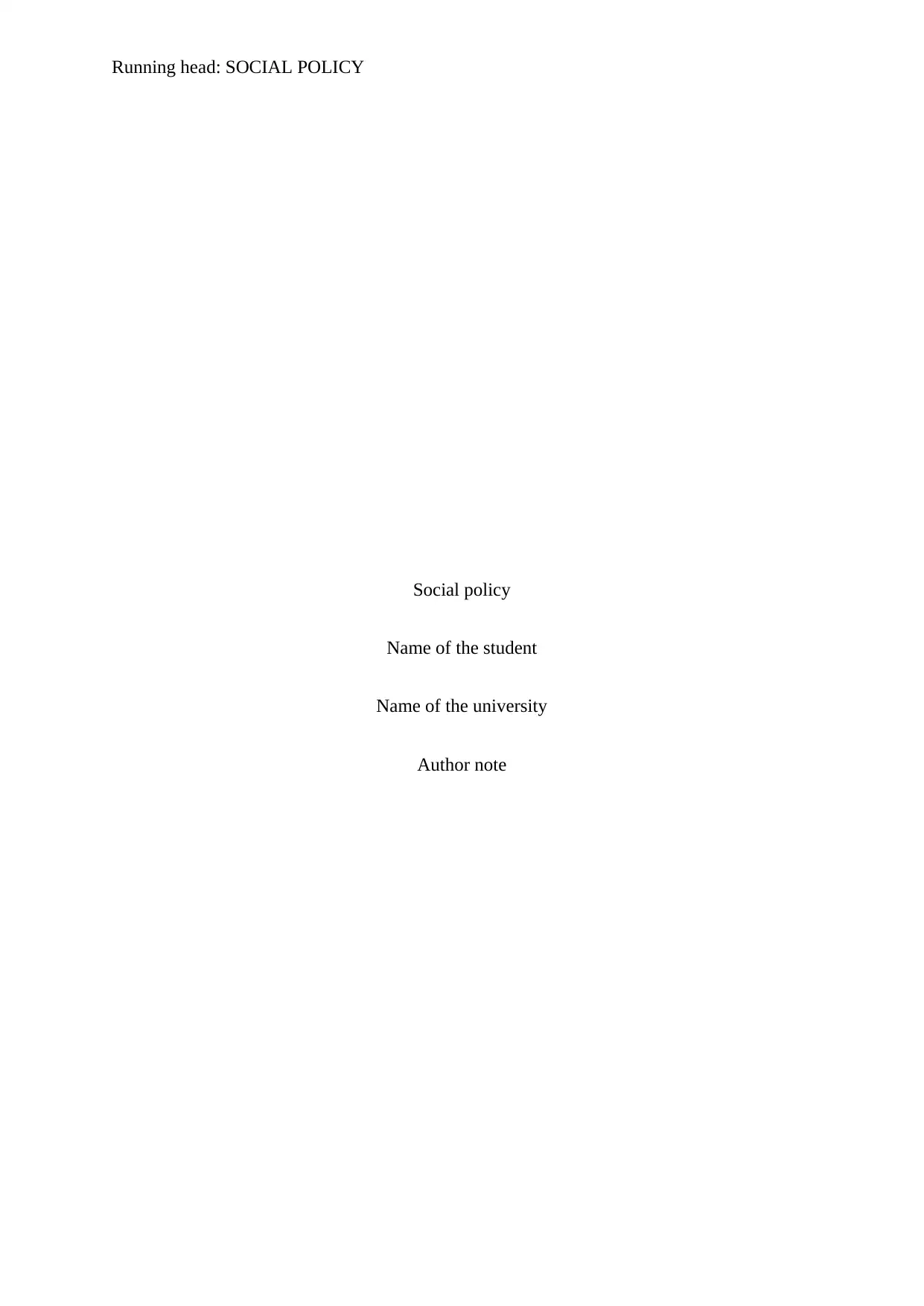
Running head: SOCIAL POLICY
Social policy
Name of the student
Name of the university
Author note
Social policy
Name of the student
Name of the university
Author note
Paraphrase This Document
Need a fresh take? Get an instant paraphrase of this document with our AI Paraphraser
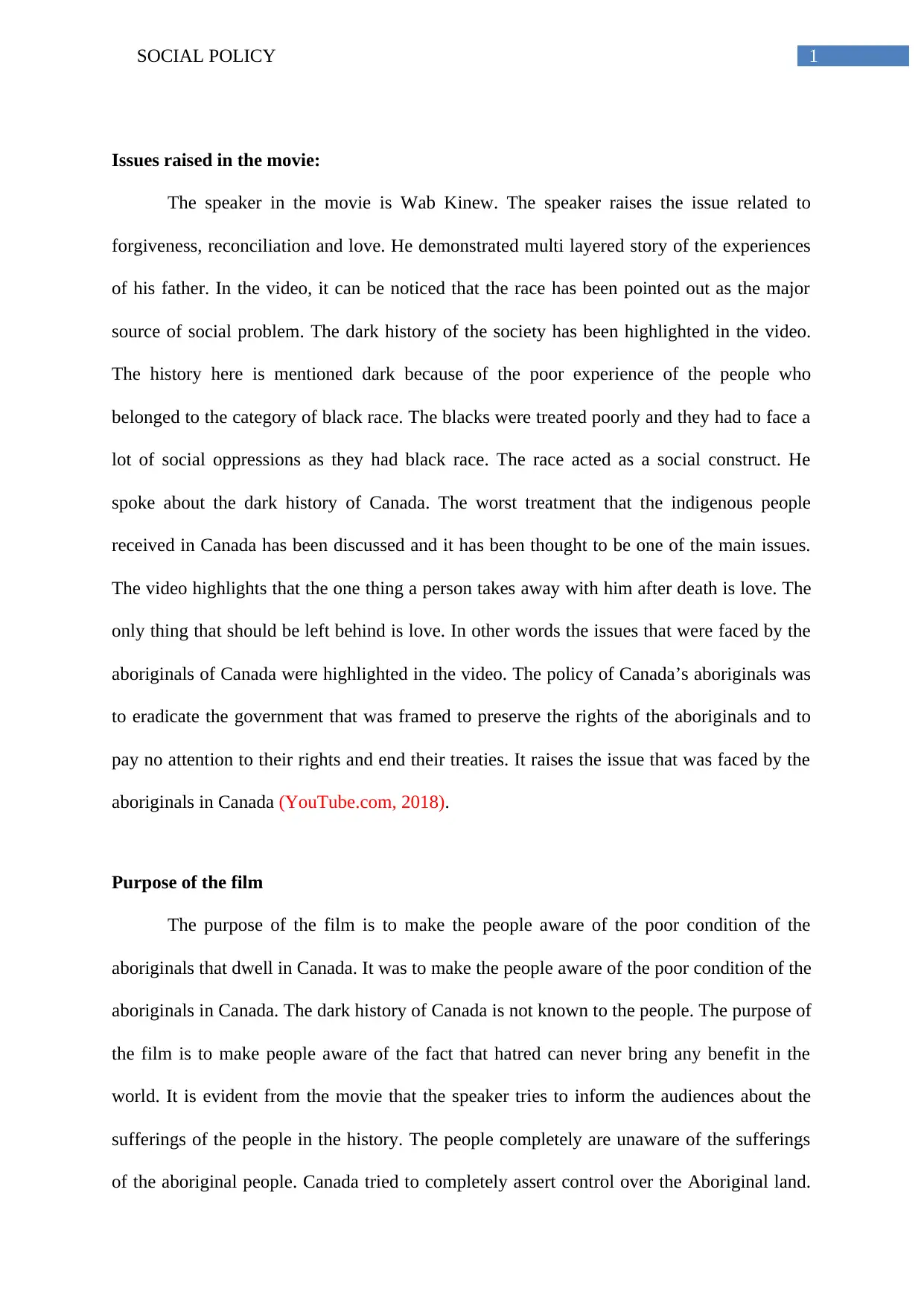
1SOCIAL POLICY
Issues raised in the movie:
The speaker in the movie is Wab Kinew. The speaker raises the issue related to
forgiveness, reconciliation and love. He demonstrated multi layered story of the experiences
of his father. In the video, it can be noticed that the race has been pointed out as the major
source of social problem. The dark history of the society has been highlighted in the video.
The history here is mentioned dark because of the poor experience of the people who
belonged to the category of black race. The blacks were treated poorly and they had to face a
lot of social oppressions as they had black race. The race acted as a social construct. He
spoke about the dark history of Canada. The worst treatment that the indigenous people
received in Canada has been discussed and it has been thought to be one of the main issues.
The video highlights that the one thing a person takes away with him after death is love. The
only thing that should be left behind is love. In other words the issues that were faced by the
aboriginals of Canada were highlighted in the video. The policy of Canada’s aboriginals was
to eradicate the government that was framed to preserve the rights of the aboriginals and to
pay no attention to their rights and end their treaties. It raises the issue that was faced by the
aboriginals in Canada (YouTube.com, 2018).
Purpose of the film
The purpose of the film is to make the people aware of the poor condition of the
aboriginals that dwell in Canada. It was to make the people aware of the poor condition of the
aboriginals in Canada. The dark history of Canada is not known to the people. The purpose of
the film is to make people aware of the fact that hatred can never bring any benefit in the
world. It is evident from the movie that the speaker tries to inform the audiences about the
sufferings of the people in the history. The people completely are unaware of the sufferings
of the aboriginal people. Canada tried to completely assert control over the Aboriginal land.
Issues raised in the movie:
The speaker in the movie is Wab Kinew. The speaker raises the issue related to
forgiveness, reconciliation and love. He demonstrated multi layered story of the experiences
of his father. In the video, it can be noticed that the race has been pointed out as the major
source of social problem. The dark history of the society has been highlighted in the video.
The history here is mentioned dark because of the poor experience of the people who
belonged to the category of black race. The blacks were treated poorly and they had to face a
lot of social oppressions as they had black race. The race acted as a social construct. He
spoke about the dark history of Canada. The worst treatment that the indigenous people
received in Canada has been discussed and it has been thought to be one of the main issues.
The video highlights that the one thing a person takes away with him after death is love. The
only thing that should be left behind is love. In other words the issues that were faced by the
aboriginals of Canada were highlighted in the video. The policy of Canada’s aboriginals was
to eradicate the government that was framed to preserve the rights of the aboriginals and to
pay no attention to their rights and end their treaties. It raises the issue that was faced by the
aboriginals in Canada (YouTube.com, 2018).
Purpose of the film
The purpose of the film is to make the people aware of the poor condition of the
aboriginals that dwell in Canada. It was to make the people aware of the poor condition of the
aboriginals in Canada. The dark history of Canada is not known to the people. The purpose of
the film is to make people aware of the fact that hatred can never bring any benefit in the
world. It is evident from the movie that the speaker tries to inform the audiences about the
sufferings of the people in the history. The people completely are unaware of the sufferings
of the aboriginal people. Canada tried to completely assert control over the Aboriginal land.
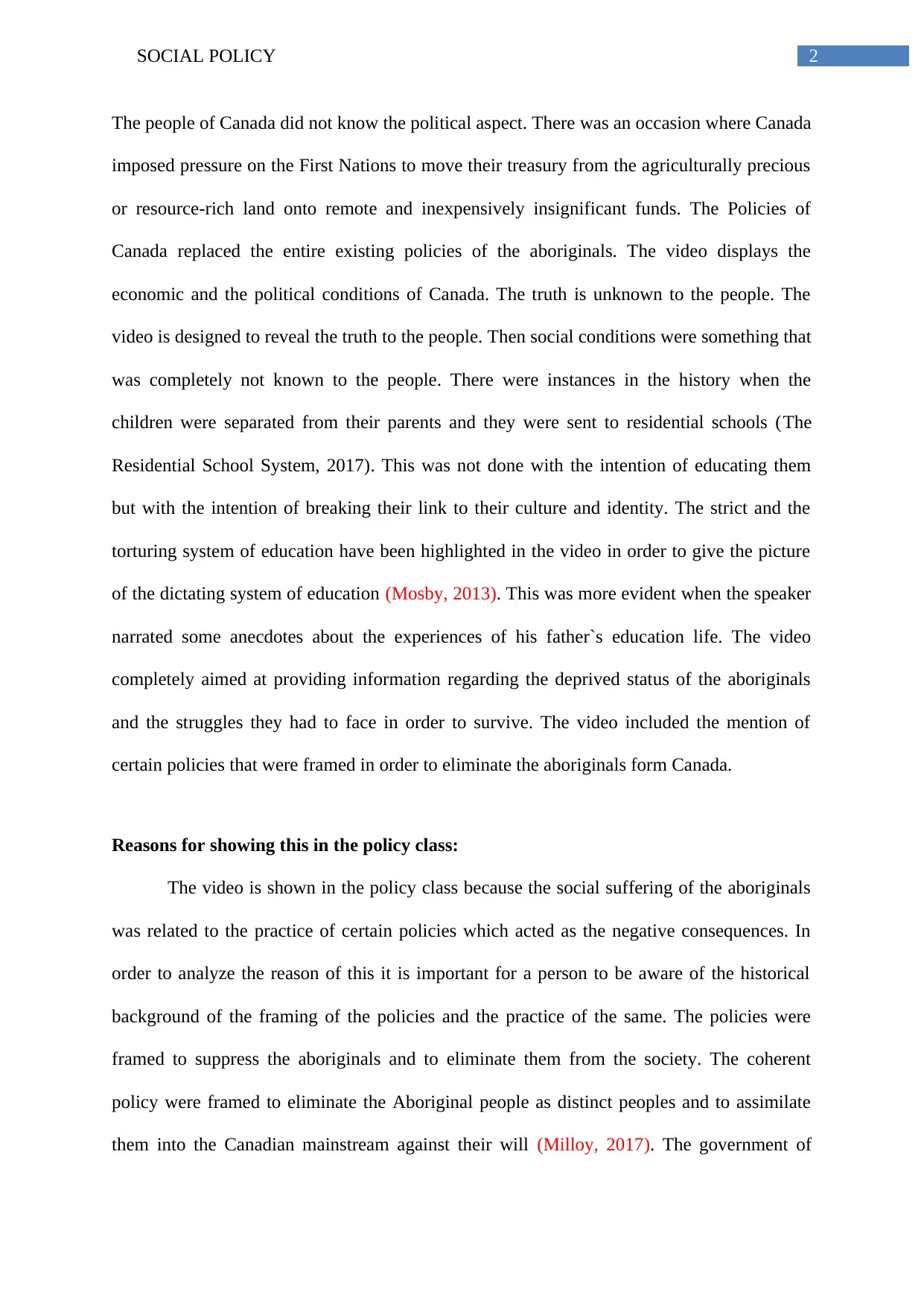
2SOCIAL POLICY
The people of Canada did not know the political aspect. There was an occasion where Canada
imposed pressure on the First Nations to move their treasury from the agriculturally precious
or resource-rich land onto remote and inexpensively insignificant funds. The Policies of
Canada replaced the entire existing policies of the aboriginals. The video displays the
economic and the political conditions of Canada. The truth is unknown to the people. The
video is designed to reveal the truth to the people. Then social conditions were something that
was completely not known to the people. There were instances in the history when the
children were separated from their parents and they were sent to residential schools (The
Residential School System, 2017). This was not done with the intention of educating them
but with the intention of breaking their link to their culture and identity. The strict and the
torturing system of education have been highlighted in the video in order to give the picture
of the dictating system of education (Mosby, 2013). This was more evident when the speaker
narrated some anecdotes about the experiences of his father`s education life. The video
completely aimed at providing information regarding the deprived status of the aboriginals
and the struggles they had to face in order to survive. The video included the mention of
certain policies that were framed in order to eliminate the aboriginals form Canada.
Reasons for showing this in the policy class:
The video is shown in the policy class because the social suffering of the aboriginals
was related to the practice of certain policies which acted as the negative consequences. In
order to analyze the reason of this it is important for a person to be aware of the historical
background of the framing of the policies and the practice of the same. The policies were
framed to suppress the aboriginals and to eliminate them from the society. The coherent
policy were framed to eliminate the Aboriginal people as distinct peoples and to assimilate
them into the Canadian mainstream against their will (Milloy, 2017). The government of
The people of Canada did not know the political aspect. There was an occasion where Canada
imposed pressure on the First Nations to move their treasury from the agriculturally precious
or resource-rich land onto remote and inexpensively insignificant funds. The Policies of
Canada replaced the entire existing policies of the aboriginals. The video displays the
economic and the political conditions of Canada. The truth is unknown to the people. The
video is designed to reveal the truth to the people. Then social conditions were something that
was completely not known to the people. There were instances in the history when the
children were separated from their parents and they were sent to residential schools (The
Residential School System, 2017). This was not done with the intention of educating them
but with the intention of breaking their link to their culture and identity. The strict and the
torturing system of education have been highlighted in the video in order to give the picture
of the dictating system of education (Mosby, 2013). This was more evident when the speaker
narrated some anecdotes about the experiences of his father`s education life. The video
completely aimed at providing information regarding the deprived status of the aboriginals
and the struggles they had to face in order to survive. The video included the mention of
certain policies that were framed in order to eliminate the aboriginals form Canada.
Reasons for showing this in the policy class:
The video is shown in the policy class because the social suffering of the aboriginals
was related to the practice of certain policies which acted as the negative consequences. In
order to analyze the reason of this it is important for a person to be aware of the historical
background of the framing of the policies and the practice of the same. The policies were
framed to suppress the aboriginals and to eliminate them from the society. The coherent
policy were framed to eliminate the Aboriginal people as distinct peoples and to assimilate
them into the Canadian mainstream against their will (Milloy, 2017). The government of
⊘ This is a preview!⊘
Do you want full access?
Subscribe today to unlock all pages.

Trusted by 1+ million students worldwide
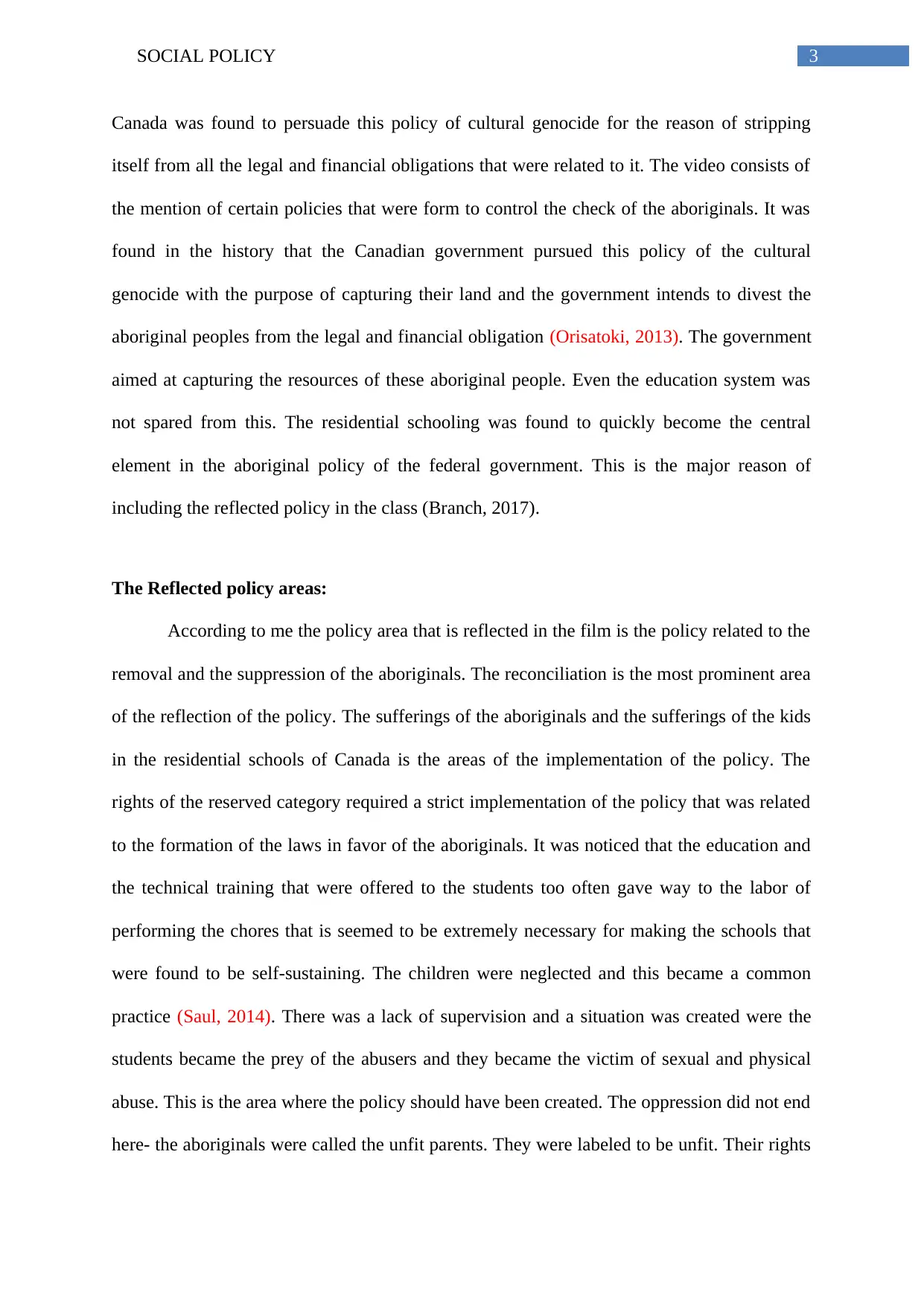
3SOCIAL POLICY
Canada was found to persuade this policy of cultural genocide for the reason of stripping
itself from all the legal and financial obligations that were related to it. The video consists of
the mention of certain policies that were form to control the check of the aboriginals. It was
found in the history that the Canadian government pursued this policy of the cultural
genocide with the purpose of capturing their land and the government intends to divest the
aboriginal peoples from the legal and financial obligation (Orisatoki, 2013). The government
aimed at capturing the resources of these aboriginal people. Even the education system was
not spared from this. The residential schooling was found to quickly become the central
element in the aboriginal policy of the federal government. This is the major reason of
including the reflected policy in the class (Branch, 2017).
The Reflected policy areas:
According to me the policy area that is reflected in the film is the policy related to the
removal and the suppression of the aboriginals. The reconciliation is the most prominent area
of the reflection of the policy. The sufferings of the aboriginals and the sufferings of the kids
in the residential schools of Canada is the areas of the implementation of the policy. The
rights of the reserved category required a strict implementation of the policy that was related
to the formation of the laws in favor of the aboriginals. It was noticed that the education and
the technical training that were offered to the students too often gave way to the labor of
performing the chores that is seemed to be extremely necessary for making the schools that
were found to be self-sustaining. The children were neglected and this became a common
practice (Saul, 2014). There was a lack of supervision and a situation was created were the
students became the prey of the abusers and they became the victim of sexual and physical
abuse. This is the area where the policy should have been created. The oppression did not end
here- the aboriginals were called the unfit parents. They were labeled to be unfit. Their rights
Canada was found to persuade this policy of cultural genocide for the reason of stripping
itself from all the legal and financial obligations that were related to it. The video consists of
the mention of certain policies that were form to control the check of the aboriginals. It was
found in the history that the Canadian government pursued this policy of the cultural
genocide with the purpose of capturing their land and the government intends to divest the
aboriginal peoples from the legal and financial obligation (Orisatoki, 2013). The government
aimed at capturing the resources of these aboriginal people. Even the education system was
not spared from this. The residential schooling was found to quickly become the central
element in the aboriginal policy of the federal government. This is the major reason of
including the reflected policy in the class (Branch, 2017).
The Reflected policy areas:
According to me the policy area that is reflected in the film is the policy related to the
removal and the suppression of the aboriginals. The reconciliation is the most prominent area
of the reflection of the policy. The sufferings of the aboriginals and the sufferings of the kids
in the residential schools of Canada is the areas of the implementation of the policy. The
rights of the reserved category required a strict implementation of the policy that was related
to the formation of the laws in favor of the aboriginals. It was noticed that the education and
the technical training that were offered to the students too often gave way to the labor of
performing the chores that is seemed to be extremely necessary for making the schools that
were found to be self-sustaining. The children were neglected and this became a common
practice (Saul, 2014). There was a lack of supervision and a situation was created were the
students became the prey of the abusers and they became the victim of sexual and physical
abuse. This is the area where the policy should have been created. The oppression did not end
here- the aboriginals were called the unfit parents. They were labeled to be unfit. Their rights
Paraphrase This Document
Need a fresh take? Get an instant paraphrase of this document with our AI Paraphraser
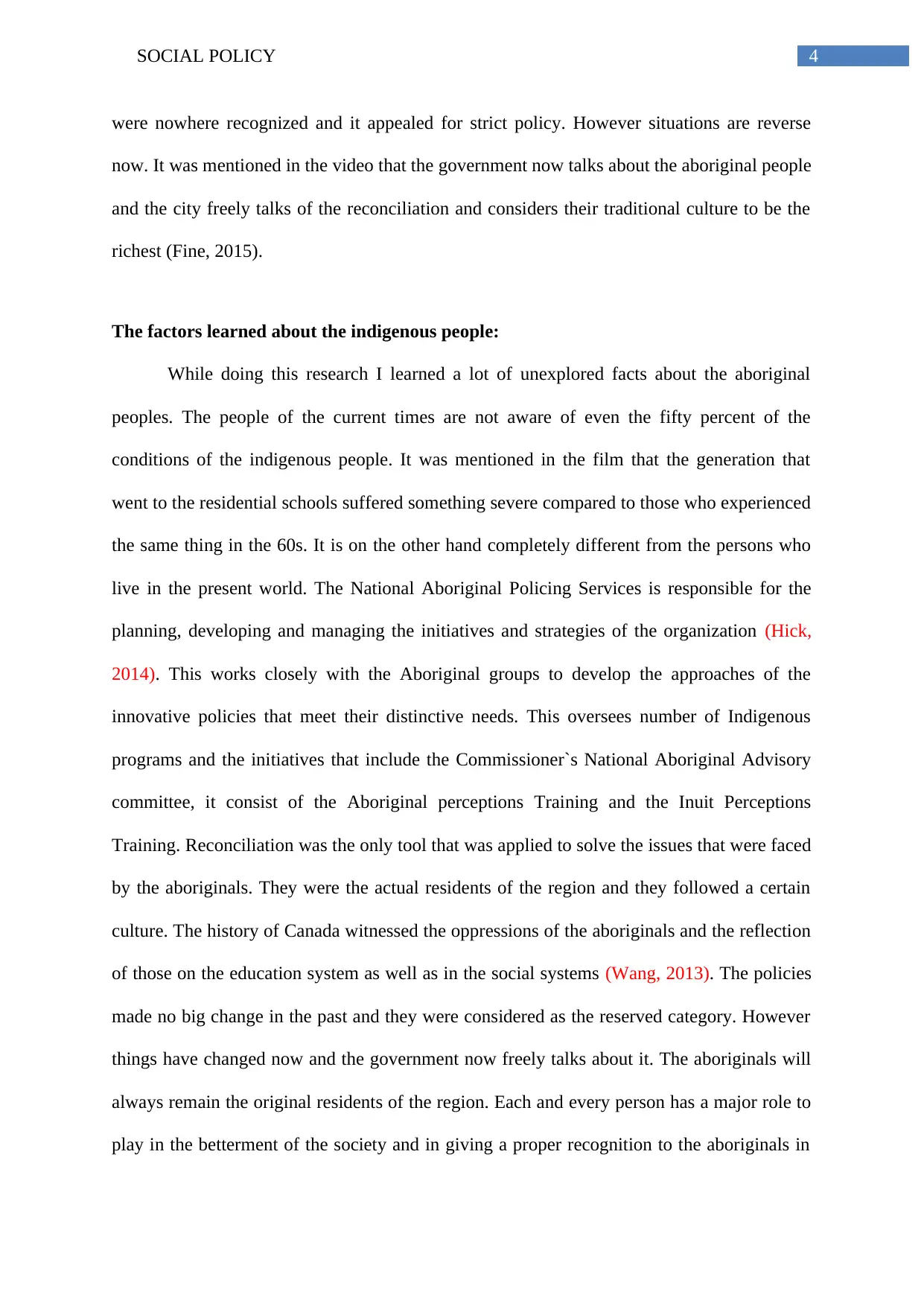
4SOCIAL POLICY
were nowhere recognized and it appealed for strict policy. However situations are reverse
now. It was mentioned in the video that the government now talks about the aboriginal people
and the city freely talks of the reconciliation and considers their traditional culture to be the
richest (Fine, 2015).
The factors learned about the indigenous people:
While doing this research I learned a lot of unexplored facts about the aboriginal
peoples. The people of the current times are not aware of even the fifty percent of the
conditions of the indigenous people. It was mentioned in the film that the generation that
went to the residential schools suffered something severe compared to those who experienced
the same thing in the 60s. It is on the other hand completely different from the persons who
live in the present world. The National Aboriginal Policing Services is responsible for the
planning, developing and managing the initiatives and strategies of the organization (Hick,
2014). This works closely with the Aboriginal groups to develop the approaches of the
innovative policies that meet their distinctive needs. This oversees number of Indigenous
programs and the initiatives that include the Commissioner`s National Aboriginal Advisory
committee, it consist of the Aboriginal perceptions Training and the Inuit Perceptions
Training. Reconciliation was the only tool that was applied to solve the issues that were faced
by the aboriginals. They were the actual residents of the region and they followed a certain
culture. The history of Canada witnessed the oppressions of the aboriginals and the reflection
of those on the education system as well as in the social systems (Wang, 2013). The policies
made no big change in the past and they were considered as the reserved category. However
things have changed now and the government now freely talks about it. The aboriginals will
always remain the original residents of the region. Each and every person has a major role to
play in the betterment of the society and in giving a proper recognition to the aboriginals in
were nowhere recognized and it appealed for strict policy. However situations are reverse
now. It was mentioned in the video that the government now talks about the aboriginal people
and the city freely talks of the reconciliation and considers their traditional culture to be the
richest (Fine, 2015).
The factors learned about the indigenous people:
While doing this research I learned a lot of unexplored facts about the aboriginal
peoples. The people of the current times are not aware of even the fifty percent of the
conditions of the indigenous people. It was mentioned in the film that the generation that
went to the residential schools suffered something severe compared to those who experienced
the same thing in the 60s. It is on the other hand completely different from the persons who
live in the present world. The National Aboriginal Policing Services is responsible for the
planning, developing and managing the initiatives and strategies of the organization (Hick,
2014). This works closely with the Aboriginal groups to develop the approaches of the
innovative policies that meet their distinctive needs. This oversees number of Indigenous
programs and the initiatives that include the Commissioner`s National Aboriginal Advisory
committee, it consist of the Aboriginal perceptions Training and the Inuit Perceptions
Training. Reconciliation was the only tool that was applied to solve the issues that were faced
by the aboriginals. They were the actual residents of the region and they followed a certain
culture. The history of Canada witnessed the oppressions of the aboriginals and the reflection
of those on the education system as well as in the social systems (Wang, 2013). The policies
made no big change in the past and they were considered as the reserved category. However
things have changed now and the government now freely talks about it. The aboriginals will
always remain the original residents of the region. Each and every person has a major role to
play in the betterment of the society and in giving a proper recognition to the aboriginals in
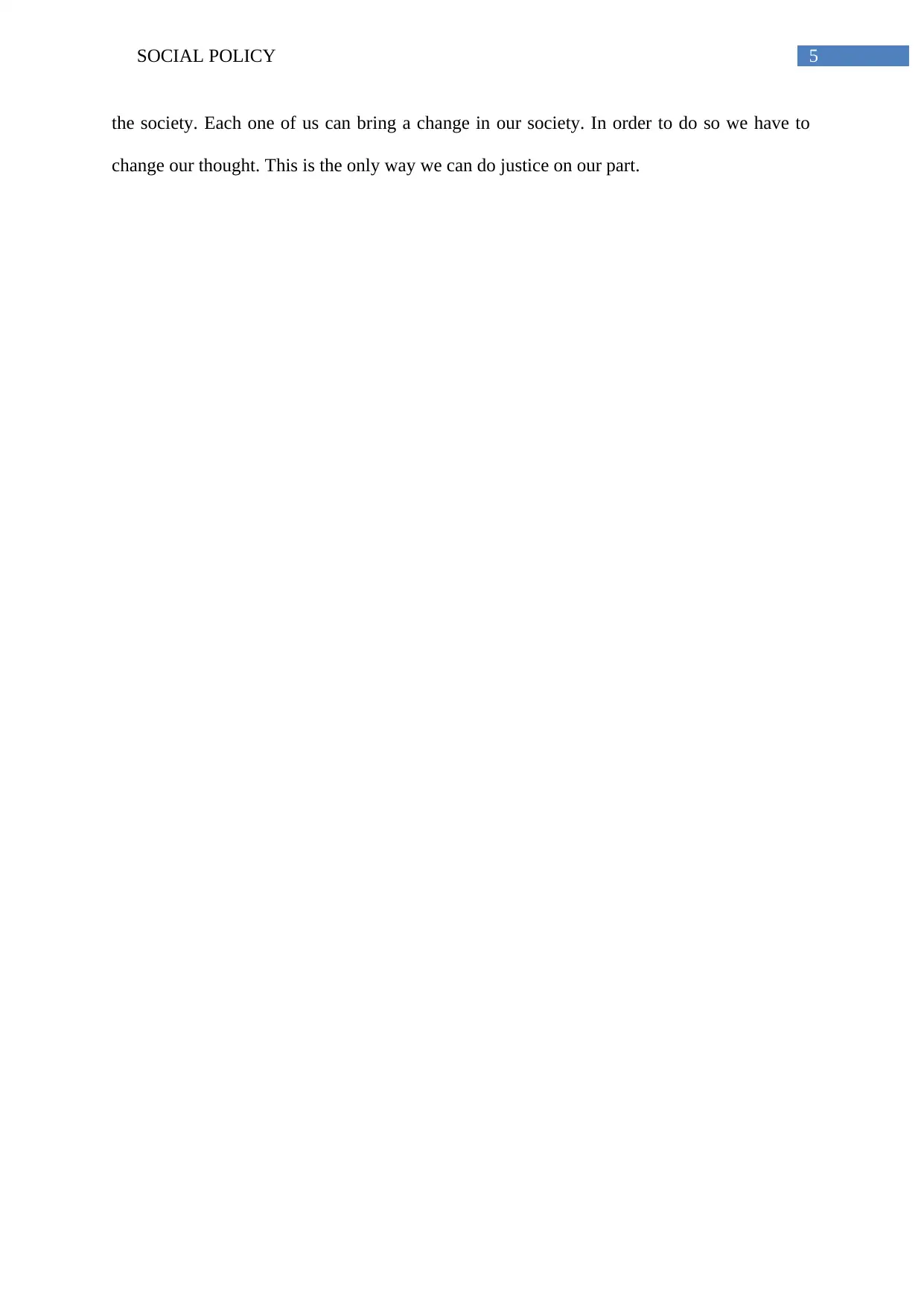
5SOCIAL POLICY
the society. Each one of us can bring a change in our society. In order to do so we have to
change our thought. This is the only way we can do justice on our part.
the society. Each one of us can bring a change in our society. In order to do so we have to
change our thought. This is the only way we can do justice on our part.
⊘ This is a preview!⊘
Do you want full access?
Subscribe today to unlock all pages.

Trusted by 1+ million students worldwide
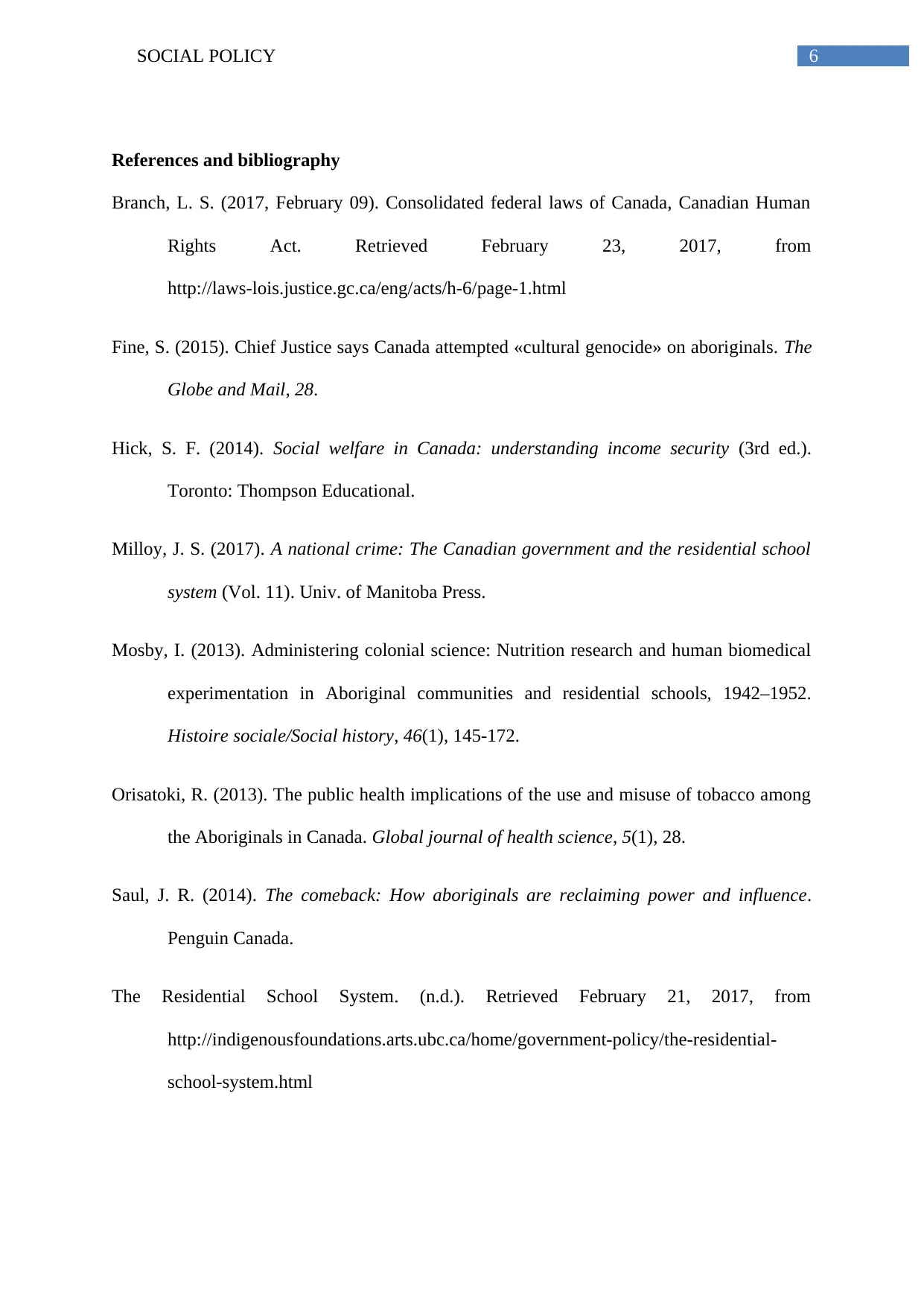
6SOCIAL POLICY
References and bibliography
Branch, L. S. (2017, February 09). Consolidated federal laws of Canada, Canadian Human
Rights Act. Retrieved February 23, 2017, from
http://laws-lois.justice.gc.ca/eng/acts/h-6/page-1.html
Fine, S. (2015). Chief Justice says Canada attempted «cultural genocide» on aboriginals. The
Globe and Mail, 28.
Hick, S. F. (2014). Social welfare in Canada: understanding income security (3rd ed.).
Toronto: Thompson Educational.
Milloy, J. S. (2017). A national crime: The Canadian government and the residential school
system (Vol. 11). Univ. of Manitoba Press.
Mosby, I. (2013). Administering colonial science: Nutrition research and human biomedical
experimentation in Aboriginal communities and residential schools, 1942–1952.
Histoire sociale/Social history, 46(1), 145-172.
Orisatoki, R. (2013). The public health implications of the use and misuse of tobacco among
the Aboriginals in Canada. Global journal of health science, 5(1), 28.
Saul, J. R. (2014). The comeback: How aboriginals are reclaiming power and influence.
Penguin Canada.
The Residential School System. (n.d.). Retrieved February 21, 2017, from
http://indigenousfoundations.arts.ubc.ca/home/government-policy/the-residential-
school-system.html
References and bibliography
Branch, L. S. (2017, February 09). Consolidated federal laws of Canada, Canadian Human
Rights Act. Retrieved February 23, 2017, from
http://laws-lois.justice.gc.ca/eng/acts/h-6/page-1.html
Fine, S. (2015). Chief Justice says Canada attempted «cultural genocide» on aboriginals. The
Globe and Mail, 28.
Hick, S. F. (2014). Social welfare in Canada: understanding income security (3rd ed.).
Toronto: Thompson Educational.
Milloy, J. S. (2017). A national crime: The Canadian government and the residential school
system (Vol. 11). Univ. of Manitoba Press.
Mosby, I. (2013). Administering colonial science: Nutrition research and human biomedical
experimentation in Aboriginal communities and residential schools, 1942–1952.
Histoire sociale/Social history, 46(1), 145-172.
Orisatoki, R. (2013). The public health implications of the use and misuse of tobacco among
the Aboriginals in Canada. Global journal of health science, 5(1), 28.
Saul, J. R. (2014). The comeback: How aboriginals are reclaiming power and influence.
Penguin Canada.
The Residential School System. (n.d.). Retrieved February 21, 2017, from
http://indigenousfoundations.arts.ubc.ca/home/government-policy/the-residential-
school-system.html
Paraphrase This Document
Need a fresh take? Get an instant paraphrase of this document with our AI Paraphraser
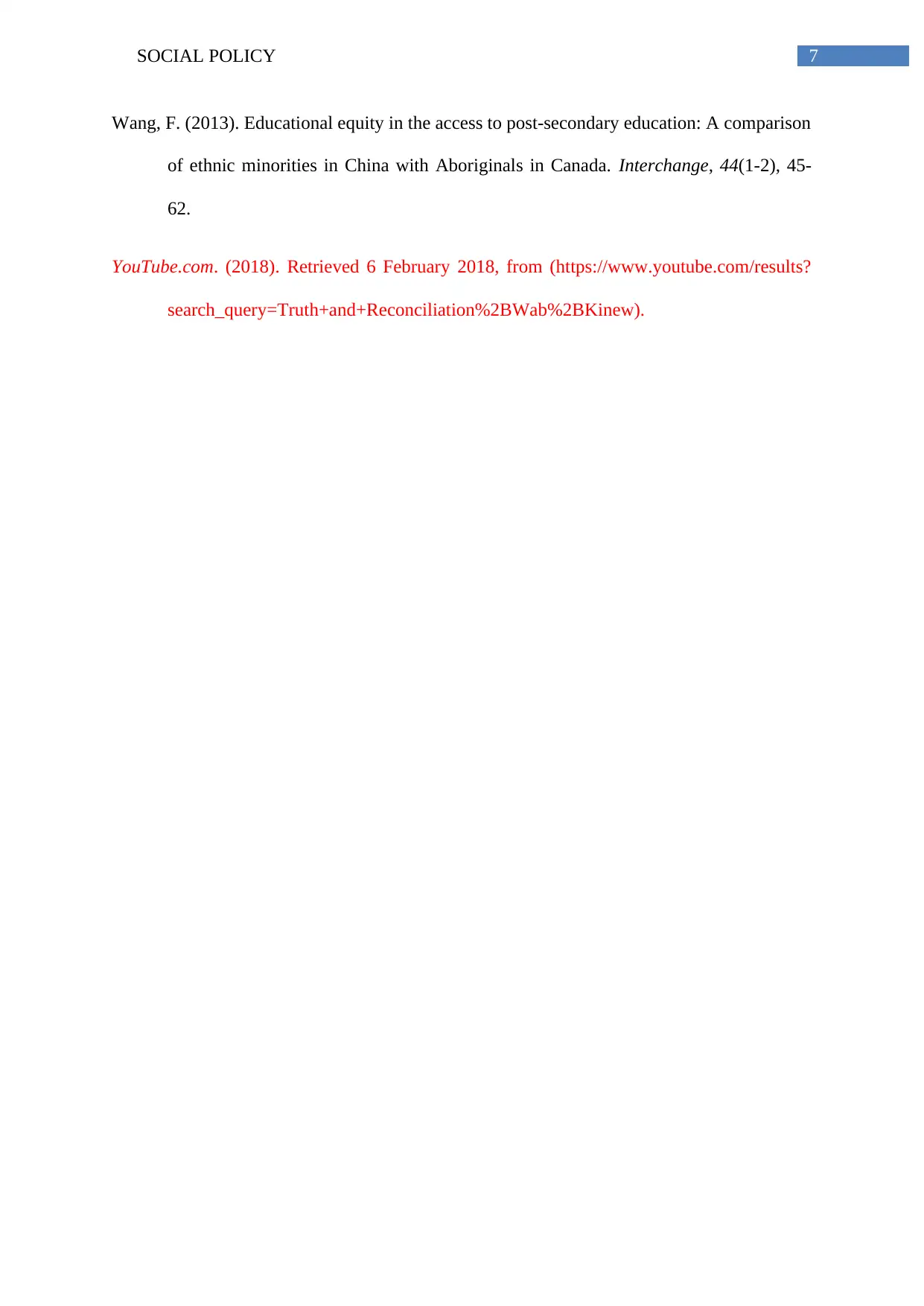
7SOCIAL POLICY
Wang, F. (2013). Educational equity in the access to post-secondary education: A comparison
of ethnic minorities in China with Aboriginals in Canada. Interchange, 44(1-2), 45-
62.
YouTube.com. (2018). Retrieved 6 February 2018, from (https://www.youtube.com/results?
search_query=Truth+and+Reconciliation%2BWab%2BKinew).
Wang, F. (2013). Educational equity in the access to post-secondary education: A comparison
of ethnic minorities in China with Aboriginals in Canada. Interchange, 44(1-2), 45-
62.
YouTube.com. (2018). Retrieved 6 February 2018, from (https://www.youtube.com/results?
search_query=Truth+and+Reconciliation%2BWab%2BKinew).
1 out of 8
Your All-in-One AI-Powered Toolkit for Academic Success.
+13062052269
info@desklib.com
Available 24*7 on WhatsApp / Email
![[object Object]](/_next/static/media/star-bottom.7253800d.svg)
Unlock your academic potential
Copyright © 2020–2025 A2Z Services. All Rights Reserved. Developed and managed by ZUCOL.